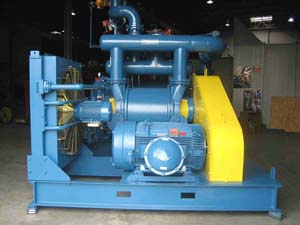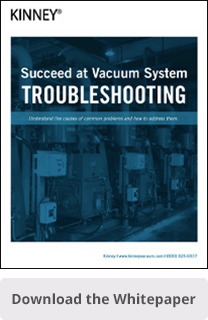Inability to reach the proper vacuum level can quickly bring productivity and processes to a halt. The first assumption is that there is a problem with the vacuum pump, but this is typically not where the issue lies.
Three Common Vacuum Problems Not Caused By The Pump

According to application engineering experts at MD-Kinney, there are three most common causes of vacuum problems, and they are surprisingly not caused by the vacuum pump:
- Pump is being operated in a condition for which it was not intended
- One or more of the user’s interface points with the pump (suction/ discharge lines, water supply, process contaminant, etc.) are being operated outside of design parameters
- The vacuum chamber or vacuum lines were improperly specified
The first step in troubleshooting vacuum pump issues is to determine whether or not the pump is the problem.
Vacuum Pump or Vacuum System Problem
In order to determine if the problem lies with the vacuum pump or system, you can mount an isolation valve and an accurate vacuum gauge in-line as close as you can to the suction connection of the vacuum pump. Close the isolation valve and measure the ultimate vacuum performance of the pump. Compare your measurement to the manufacturer’s published ultimate vacuum value. If your value is reasonably close to the manufacturer’s, the problem is probably leaks or outgassing in the vacuum system.
Possible Issues for Both Wet And Dry Vacuum Technologies
- Vacuum leaks – Any vacuum system will have some amount of air leakage, which may or may not be known when the vacuum pump is sized. The process gas pumping capacity may be reduced if excessive leakage is happening, which occurs at the joints of the vacuum line and vacuum chamber.
- Excessive pump discharge or back pressure – A vacuum pump is engineered to discharge to atmospheric pressure or just slightly above unless it is designated a compressor by the manufacturer. As the discharge pressure of the pump increases above atmospheric pressure, this raises the differential pressure across the pump, resulting in higher pump temperature and possible overheating.
- Improperly sized suction and discharge lines – Sizing of system piping significantly affects pump performance and should be performed by qualified vacuum engineers.
- Isolation of pumps operated in parallel – Many vacuum pump installations consist of multiple pumps operating in parallel and utilize a common suction and discharge header. Failure to isolate the offline pumps may result in discharge gas from the operating pumps contaminating idle pumps or creation of vacuum in idle pumps, resulting liquid back-stream into the vacuum lines and chamber.
Prevent Vacuum Pump Issues Before They Occur
The best way to deal with vacuum pump problems is to keep them from happening. Many vacuum pumps can be headed off by doing a pre-startup check of blower, vacuum, or vacuum pump equipment that has not been in operation for a while. Refer to our pre-start checklist of items and run through to ensure your equipment will perform properly and reliably.
If you have a Kinney vacuum system, download Kinney’s official troubleshooting guide that highlights the causes of common problems and how to address them.

